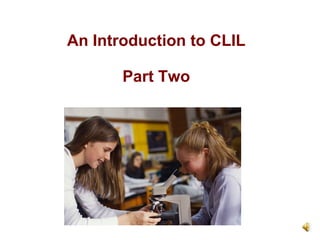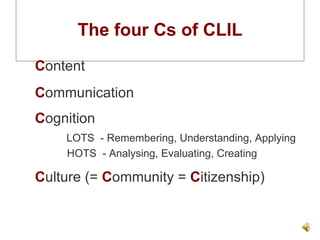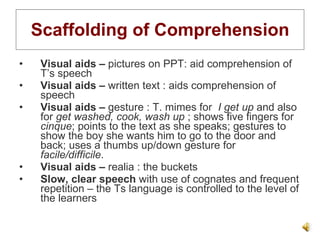An Introduction to CLIL Part Two
- 1. An Introduction to CLIL Part Two
- 2. The four Cs of CLIL C ontent C ommunication C ognition LOTS - Remembering, Understanding, Applying HOTS - Analysing, Evaluating, Creating C ulture (= C ommunity = C itizenship)
- 3. An example ¡ http://www.primarylanguages.org.uk/training_zone/teachers/embedding/clil.aspx Did that lesson include objectives and learning outcomes for each of the 4 Cs? Content? Communication? Cognition? Culture?
- 4. Can we identify content objectives and outcomes? Increase knowledge/understanding of : the location of Cameroon the life of a village child in the Cameroon water availability and use
- 5. Can we identify communication objectives and outcomes? Consolidation of expressions used to give personal information : Je m¡¯appelle ¡ J¡¯ai 14 ans.. J¡¯habite .. Consolidation of weather vocabulary : faire du soleil, pleuvoir Consolidation of knowledge of pronunciation of en Key vocabulary and expressions connected to the life of the child : dans un village, en Afrique, une hutte, un point d¡¯eau, un seau Key vocabulary connected to water use : se laver, faire la vaisselle, prendre un bain etc
- 6. Can we identify cognition objectives and outcomes? Infer meaning of new language through interpreting visual clues and recognising cognates. Compare and contrast life in the Cameroon and in Britain Evaluate the relative importance of different uses of water and justify their decisions
- 7. Can we identify culture / community / citizenship objectives and outcomes? Develop an understanding of differences between their own lifestyle and that of a child from an African village. Develop an understanding of the importance of water for life and lifestyle and its potential scarcity
- 8. Some comments on the lesson The purpose of the activities Incorporation of activities aimed at various learning styles Promotion of language learning - scaffolding of comprehension - expectations for production - scaffolding for production - use of the L1 - attitude to error
- 9. The purpose of the activities Almost all activities have more than one purpose ¨C ie they integrate more than one of the Cs.
- 10. Example Deciding how to allocate the available water Cognition : Reasoning (learners have to proritise uses depending on a logical assessment of the importance of the use, and the amount of water required and available) Communication : Consolidation of key vocabulary
- 11. The Purpose of the Activities Only exception ¨C the mime activity. Functions only to consolidate target language items? But even this has other ¡°non-C¡± purposes : - incorporation of kinaesthetic activity
- 12. Learning Styles Visual ¨C Pics and text on PPT, realia; the T¡¯s gestures; pics on the learners¡¯ writing sheets; watching the boy carrying the buckets. Auditory ¨C listening to the T¡¯s text Kinaesthetic / Tactile ¨C the T¡¯s gestures; the animated entrance of the buckets on PPT; the boy¡¯s demonstration; the mime activity; the writing activity.
- 13. Scaffolding of Comprehension Visual aids ¨C pictures on PPT: aid comprehension of T¡¯s speech Visual aids ¨C written text : aids comprehension of speech Visual aids ¨C gesture : T. mimes for I get up and also for get washed, cook, wash up ; shows five fingers for cinque ; points to the text as she speaks; gestures to show the boy she wants him to go to the door and back; uses a thumbs up/down gesture for facile/difficile . Visual aids ¨C realia : the buckets Slow, clear speech with use of cognates and frequent repetition ¨C the Ts language is controlled to the level of the learners
- 14. Productive Language Use Relatively little ¨C it is restricted to the word and phrase level . - Luke is asked to use only the words oui and difficile . The latter is scaffolded by the T. providing the alternatives C¡¯est facile ou difficile? and using a thumbs up/down gesture. - In the writing activity the phrases are on the IWB for the learners to copy. - In the mime activity, the speaker has the phrases written and can read them out.
- 15. Use of the L1- by the learners English is used : - for discussion which would be above the learners¡¯ productive level but achieves the content/cognitive objectives of the lesson. - Learners who are unable to reply in L2 are allowed to do so in L1, whilst others who want to try in the L2 have the chance to do so ¨C or even in a mix : notice Gemma who says Afrique is ¨C like .... really, erm ... it hasn¡¯t got much water. - to fill ¡°gaps¡±. Notice the ¡°strong¡± learner who offers Je me lave but then has to switch to English for It¡¯s hygienic. This is accepted and reformulated in French by the teacher, but there is no focus on the expression.
- 16. Use of the L1 ¨C by the T The teacher rarely uses English when discussing the content or giving instructions, preferring to get her meaning across with visuals, gestures etc. But she will do so if she thinks a learner has not understood : Pourquoi? Why? Note how this use of English also gives the learner ¡°permission¡± to reply in L1, and turns her slight look of panic back to a smile as she replies. The teacher switches to English to talk about the language (the pronunciation of dents )
- 17. Attitude to error All contributions are accepted and praised by the teacher Excellent! with no correction of L2 mistakes. ??
- 18. The Competencies of the CLIL Teacher Subject knowledge Subject teaching competencies Age group teaching competencies : the CLIL teacher as educator Language competence Language awareness Language teaching competencies
- 19. Consequently ¡ ¡ the ideal CLIL teacher is an expert user of the language, with a relevant degree and trained both as a subject teacher and language teacher for the specific age group.
- 20. Problems and Solutions¡ The problem of teacher availability : how many teachers possess all six areas of competence? Non-NS subject teachers may need additional language development Subject teachers may need additional training in language awareness and CLIL methodology Language teachers may need additional training in subject teaching competencies The need for teacher collaboration
- 21. Problems and Solutions Lack of materials The myth of the miracle method
- 22. This presentation is part of an on-line course run by Business Talk Milan for the Cambridge ESOL Delta Modules If you would like to find out more about our on-line and face-to-face training courses, please contact us via our website : www.business-talk.it





















